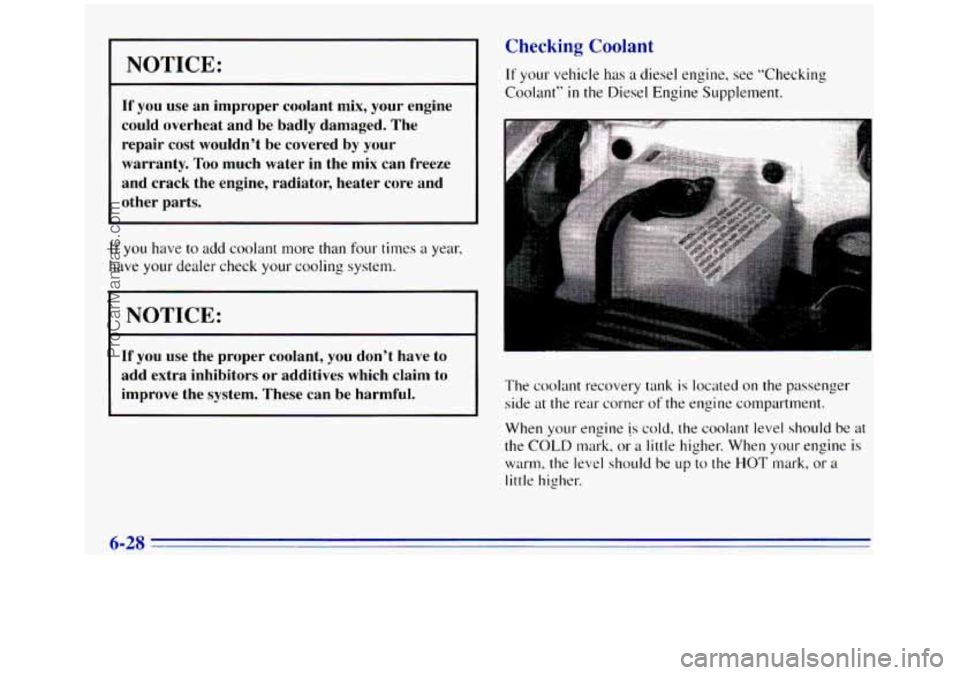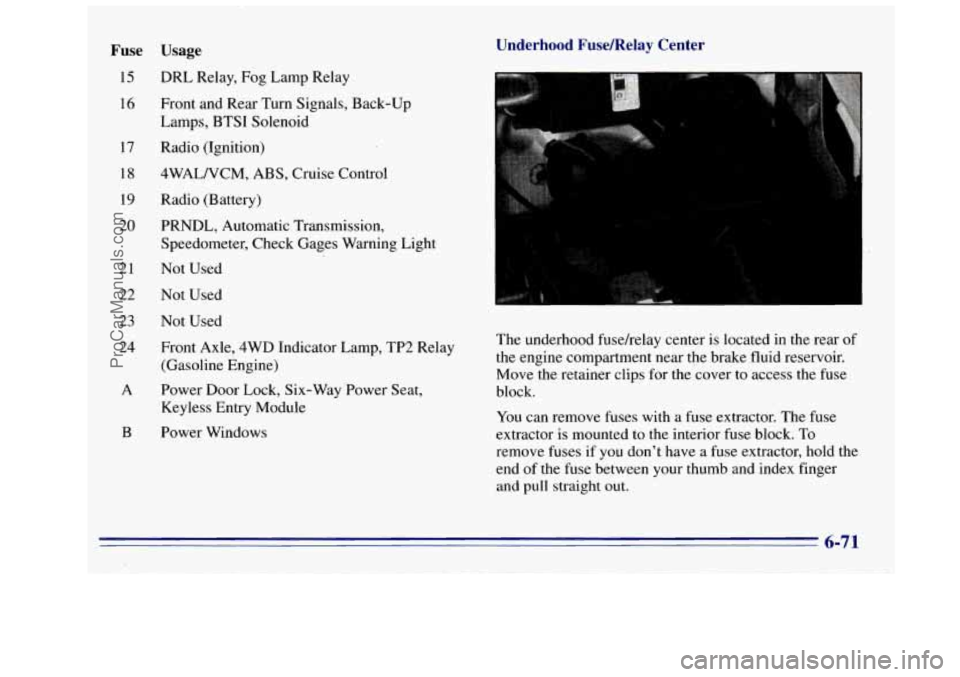1996 GMC SIERRA check engine
[x] Cancel search: check enginePage 270 of 404

Checking Transmission Fluid Hot
Get the vehicle warmed up by driving about 15 miles
(24 km) when outside temperatures are above 50°F
(10°C). If it's colder than 50°F (lO"C), drive the
vehicle
in DRIVE (D) until the engine temperature
gage moves and then remains steady for
10 minutes.
Then
follow the hot check procedures.
Checking Transmission Fluid Cold
A cold check is made after the vehicle has been sitting
for eight hours or more with the engine off and is used
only
as a reference. Let the engine run at idle for five
minutes
if outside temperatures are 50°F (10°C) or
more. If it's colder than 50°F (lO"C), you may have to
idle the engine longer. Should
the fluid level be low
during a cold check, you nwst perform a hot check
before adding fluid. This will give you
a more accurate
reading
of the fluid level.
Checking the Fluid Hot or Cold
0 Park your vehicle on a level place. Keep the
engine running.
With the parking brake applied, place the shift lever
in PARK (P).
-,
With your foot on the brake pedal, move the shift
lever through each gear range, pausing for about three
seconds
in each range. Then, position the shift
lever
in PARK (P).
Let the engine run at idle for three minutes or more.
Then, without shutting off the engine, follow these steps:
The red transmission dipstick handle
is located at the
rear
of the engine compartment, on the passenger side.
I. Flip the handle up and then pull out the dipstick and
wipe
it with a clean rag or paper towel.
2. Push it back in all the way, wait three seconds and
then pull
it back out again.
6-20
ProCarManuals.com
Page 272 of 404

Manual Transmission Fluid
When to Check
A good time to have it checked is when the engine
oil
is changed. However, the fluid in your manual
transmission doesn’t require changing.
How to Check
Because this operation can be a little difficult, you
may choose to have this done at your GM dealership
Service Department.
If you do it yourself, be sure to follow all the
instructions here, or you could get
a false reading.
NOTICE:
Too much or too little fluid can damage your
transmission.
Too much can mean that some of
the fluid could come out and fall on hot engine
parts or exhaust system parts, starting a fire.
Be
sure to get an accurate reading if you check your
transmission fluid.
II
Check the fluid level only when your engine is off, the
vehicle
is parked on a level place and the transmission
is cool enough for you to rest your fingers on the
transmission case.
Then, follow these steps:
1. Remove the filler plug.
2. Check that the lubricant level is up to the bottom of
the filler plug hole.
3. If the fluid level is good, install the plug and be sure
it is fully seated. If the fluid level is low, add more
fluid as described in the next steps.
6-22
ProCarManuals.com
Page 276 of 404

Front Axle
When to Check and Change Lubricant
Refer to the Maintenance Schedule to determine how
often
to check the lubricant and when to change it. See
"Scheduled Maintenance Services"
in the Index.
How to Check Lubricant
If the level is below the bottom of the filler plug hole.
you'll
need to add some lubricant.
If the differential is at operating temperature (warm),
add enough lubricant
to raise the level to the bottom of
the filler plug hole.
If the differential is cold, add enough lubricant to raise
the level
to 1/2 inch (1 2 mm) below the filler plug hole.
What to Use
Refer to the Maintenance Schedule to determine what
kind
of lubricant to use. See "Recommended Fluids and
Lubricants"
in the Index.
Engine Coolant
The cooling system in your vehicle is filled with new
DEX-COOL
TM (orange-colored, silicate-free) engine
coolant. This coolant is designed
to remain in your
vehicle for
5 years or 100,000 miles (1 66 000 km),
whichever occurs first.
The following explains
your cooling system and how
to add coolant when it is low. If you have a problem
with engine overheating, see "Engine Overheating"
in
the Index.
6-26
ProCarManuals.com
Page 278 of 404

NOTICE:
If you use an improper coolant mix, your engine
could overheat and be badly damaged. The
repair cost wouldn't be covered by your
warranty.
Too much water in the mix can freeze
and crack the engine, radiator, heater core and
other parts.
If you have to add coolant more than four times 8 year,
have
your dealer check your cooling system.
NOTICE:
If you use the proper coolant, you don't have to
add extra inhibitors or additives which claim to
improve the system. These can be harmful.
Checking Coolant
If your vehicle has a diesel engine, see "Clwcking
Coolant"
in the Diesel Engine Supplement.
d
The coolant recovery tank is located on the passenger
side at the rear corner of the engine compartment.
When your engine
is cold, the coolant level should be at
the
COLD mark, or a little higher. When your engine is
warm. the level sho~~ld be up to the HOT mark, or a
little higher.
6-28
ProCarManuals.com
Page 281 of 404

Power Steering Fluid
When to Check Power Steering Fluid
It is not necessary to regularly check power steering
fluid unless
you suspect there is a leak in the system or
you hear an unusual noise. A fluid loss in this system
could indicate
a problem. Have the system inspected
and repaired.
How To Check Power Steering Fluid
When the engine cotnparttnent is cool, unscrew the cap
and
wipe the dipstick with a clean rag. Replace the cap
and completely tighten
it. Then remove the cap again
and
look at the fluid level on the dipstick.
The level should he at the FULL COLD mark. If
necessary, add only enough fluid to bring the level up
to the mark.
What to Use
Refer to the Maintenance Schedule to determine what
kind
of fluid to use. See “Recommended Fluids and
Lubricants” in the Index. Always use the proper fluid.
Failure to
use the proper fluid can cause leaks and
damage hoses and seals.
Windshield Washer Fluid
What to Use
When you need windshield washer fluid, be sure to read
the manufacturer’s instructions before use. If you will be
operating
your vehicle in an area where the tetnperature
may
fill1 below freezing, use a fluid that has sufficient
protection against freezing.
6-3 1
ProCarManuals.com
Page 283 of 404

Brakes
Brake Fluid
Your brake master cylinder
reservoir
is here. It is filled
I with DOT-3 brake fluid.
There are
only two reasons why the brake fluid level in the
reservoir might go down. The first is that
the brake fluid
goes down to an acceptable level during normal brake lining wear. When new linings are put
in, the fluid level
goes back
up. The other reason is that fluid is leaking out
of the brake system. If it is, you should have your brake
system fixed, since a leak
means that sooner or later your
brakes
won’t work well, or won’t work at all.
So, it isn’t a good idea to “top off’ your brake fluid.
Adding
brake fluid won’t correct a leak. If you add fluid
when your linings are worn, then you’ll have
too much
fluid
when you get new brake linings. You should add
(or remove) brake fluid,
as necessary, only when work is
done on the brake hydraulic system.
A CAUTION0
If you have too much brake fluid, it can spill
on the engine. The fluid will burn if the engine
is hot enough. You or others could be burned,
and your vehicle could be damaged. Add brake
fluid only when work
is done on the brake
hydraulic system.
Refer to the Maintenance Schedule to determine when to
check your brake fluid. See “Periodic Maintenance
Inspections”
in the Index.
6-33
ProCarManuals.com
Page 321 of 404

Fuse Usage
15 DRL Relay, Fog Lamp Relay
Underhood Fusemelay Center
16
17
18
19
20
21
22
23 24 Front and Rear Turn
Signals, Back-up
Lamps, BTSI Solenoid
Radio (Ignition)
4WALNCM, ABS, Cruise Control
Radio (Battery)
PRNDL, Automatic Transmission,
Speedometer, Check Gages Warning Light
Not Used
Not Used
Not Used
Front Axle, 4WD Indicator Lamp, TP2 Relay
(Gasoline Engine)
A Power Door Lock, Six-Way Power Seat,
Keyless Entry Module
B Power Windows The underhood
fusehelay center is located in the rear
of
the engine compartment near the brake fluid reservoir.
Move the retainer clips for the cover to access the fuse
block.
You can remove fuses with a fuse extractor. The fuse
extractor
is mounted to the interior fuse block. To
remove fuses if
you don’t have a fuse extractor, hold the
end of the fuse between your thumb and index finger
and
pull straight out.
6-71
ProCarManuals.com
Page 329 of 404

Part A: Scheduled Maintenance
Services
Using Your Maintenance Schedule
We at General Motors want to help you keep your
vehicle
in good working condition. But we don’t know
exactly how you’ll drive
it. You may drive very short
distances only a few times a week. Or
you may drive
long distances all the time
in very hot, dusty weather.
You may use your vehicle in making deliveries.
Or you may drive
it to work, to do errands or in
many other ways.
Because
of all the different ways people use their GM
vehicles, maintenance needs vary. You may even need
more frequent checks and replacements than you’ll find
in the schedules in this section. So please read this
section and note how
you drive. If you have any
questions on
how to keep your vehicle in good
condition, see your GM dealer.
This part tells
you the maintenance services you should
have done and when
you should schedule them. If you
go to your dealer for your service needs, you’ll know
that GM-trained and supported service people will
perform the work using genuine GM parts.
The proper fluids and lubricants to
use are listed in
Part D. Make sure whoever services your vehicle uses these.
All parts should be replaced and all necessary
repairs done before
you or anyone else drives the vehicle.
These schedules are for vehicles that:
carry passengers and cargo within recommended
limits. You will find these limits
on your vehicle’s
CertificatiodTire label. See “Loading Your Vehicle”
in the Index.
are driven on reasonable road surfaces within legal
driving limits.
are driven off-road in the recommended manner. See
”Off-Road Driving With Your Four-Wheel-Drive
Vehicle”
in the Index.
use the recommended fuel. See “Fuel” in the Index.
Selecting the Right Schedule
First you’ll need to decide which of the two schedules is
right for your vehicle.
Here’s how to decide which
schedule
to follow:
Gasoline engine vehicles and diesel engine vehicles
have different maintenance requirements.
If you have a
diesel engine, follow a schedule designated
for diesel
engine vehicles only.
See the Diesel Engine Supplement for diesel engine
maintenance schedules.
7-3
ProCarManuals.com